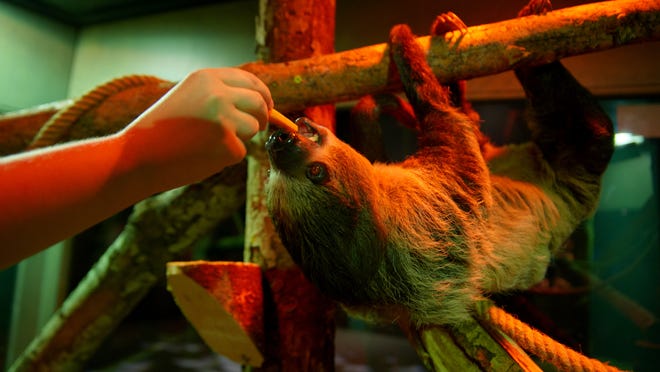Milwaukee Public Museum features live animals in 'Survival of the Slowest' exhibit
 Amy Schwabe
Amy Schwabe
You probably don’t think of live animals when you think of the Milwaukee Public Museum, but you probably should. In addition to the popular Puelicher Butterfly Wing and the nearby Bugs Alive! permanent exhibits, the museum has hosted traveling exhibits of both frogs and snakes over the past few years.
And now, the museum’s upcoming traveling exhibit, Survival of the Slowest, will feature 16 different species of animals, from a green iguana to a chameleon to a tortoise to a sloth.
The live-animal exhibit will be in the museum’s second floor special exhibit gallery from Feb. 11 to May 19. Animal educators and caretakers will be on hand throughout the exhibit to answer questions, and visitors will often get to touch animals and watch them being fed. In addition, during the museum’s busiest times, such as weekends and during Milwaukee Public Schools' spring break, scheduled hands-on presentations will showcase the animals' survival adaptations.
Slower can be better
The educators' presentations, the signage and activities in the exhibit, and the opportunity to look at the animals themselves will all work together to educate visitors about evolution and the adaptations that smaller, slower animals have gained to help them survive.
"A lot of times, people think that animals that are the strongest and mightiest are the most fit for survival, but animals who are slow and don't have to use so much energy have survival benefits too," said Jon Bertolas, supervisor of the Puelicher Butterfly Wing and the onsite curator for the traveling exhibit. "Generally speaking, people stand to benefit from a whole new perspective to look at evolutionary biology in a different way than they're used to."
Bertolas said a visit to see live animals is also a good time to look through the museum's permanent exhibits to see how MPM researchers keep up-to-date on new discoveries regarding evolution. For example, a portion of the rainforest exhibit explores the adaptations moths have evolved to jam the echolocation capability of bats in order to avoid becoming their prey.
Lessons that will stick in people's minds
Museum administrators were excited to bring this exhibit to Milwaukee because hands-on, interactive exhibits — especially those that feature live animals — are so engaging and memorable.
"The value of a live animal exhibit is the connection and the opportunity to observe behaviors," said Bertolas. "There are so many things a person can learn about animals and evolution without even reading about them. And that experience connects people with what they've learned so they'll remember it a little better."
And it's not just the engagement with the animals that helps cement those lessons in visitors' minds. Bertolas has seen in the Butterfly Wing that when visitors are able to interact with experts and ask questions, they're also more likely to absorb the information they learn.
The exhibit is curated by Little Ray's Nature Centre, a Canadian animal rescue organization. Because of the group's mission, much of this exhibit focuses on raising awareness of animal conservation efforts. Most of the animals in the exhibit are rescue animals that were either seized by the government or surrendered by owners who weren't able to care for them as pets.
"Little Ray's staff will be teaching lessons about not taking on an animal you're not able to properly care for," said Bertolas. "These rescue animals have become ambassador animals to connect people to conservation efforts."
If you go
"Survival of the Slowest" will be at Milwaukee Public Museum, 800 W. Wells St., from Feb. 11-May 19. Info: mpm.org.